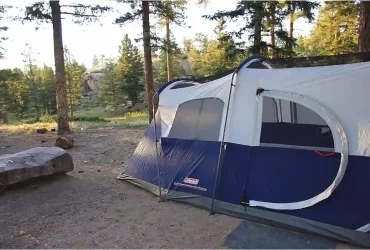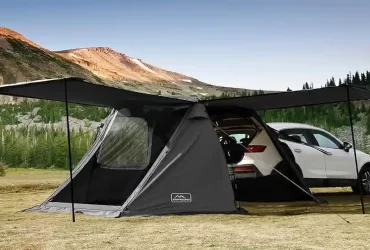The footprints of tents are not necessary, but they can increase their lifespan. For ultralight tents with low denier floors, adding a footprint or making your own might be worth the extra cost. We remove rocks, pinecones, and twigs from our campsites regardless of whether there are footprints.
It is an excellent idea to invest in a tent footprint if you camp on rough ground or wish to extend the life of your gear. Tent footprints make sense not only for cowboy camping, but also for tent camping. You will not find that a ground sheet makes or breaks your trip very often. Before you go on your first camping trip, find out if you can find a tent footprint beforehand, and bring a best tent.
Also like this:
What is the purpose of a footprint?
Footprints protect your tent floor from damage by acting as lightweight ground sheets. As backpackers, we should camp on durable surfaces whenever possible (rocks, gravel, or established campsites). Due to the fact that these surfaces act like sandpaper, they eventually erode tent fabric and waterproofing over time.
It is possible for a rock or root to puncture the tent floor, creating a hole that can be difficult to repair. Using the footprint, you are separated from the ground as if you were wearing a second skin. A footprint is not necessary given the higher cost and weight, and you have many options, all of which are discussed below.
How Does a Footprint Work?

Many people believe footprints add waterproofing to tents; indeed, modern tents usually have waterproof floors made of materials like dyneema or silnylon. In addition to protecting the tent floor from abrasive objects (like sticks, roots, and rocks), footprints can help clean the tent and determine the best place to pitch it.
Abrasive Stuff
Repeated rubbing of the same spot on thin tents can eventually cause fabric to fray from the smallest twigs or pebbles. A footprint can protect your tent from abrasive objects and extend its lifespan. By choosing your camping site carefully and cleaning debris thoroughly before pitching your tent, you can reduce the chances of mishaps.
Awkward Angles
There’s nothing like finding the perfect spot for pitching your tent, as if it was designed just for it. Upon unloading your pack and staking out your tent, you discover that one root prevents your tent from fitting into the space you’ve chosen. Most spatial planning guesswork can be avoided by first setting up a footprint (especially if you’ll be pitching multiple tents).
Messy Stuff
It makes sense that our gear will accumulate a little dirt when we take it outside, but sticky tree sap can be a big problem on the bottom of your tent. Footprints can take the brunt of sap and berry stains on your tent, keeping it in pristine condition for longer.
How Much Does a Footprint Cost and Weigh?
Footprints are available from some outdoor gear companies that match seamlessly with tents. Having this footprint in this color scheme and fitting perfectly is an added bonus. Footprints that match your tent can cost anywhere from $30 to $80, depending on the fabric and size. A footprint adds significantly to the weight of the tent, which weighs 3 pounds 2 ounces and costs $500. The calculation indicates an increase of 16% in cost and 10% in weight.
Here’s a guide to DIY tent footprints that are lighter and cheaper. Rainwater won’t divert beneath the tent and create a wet, cold pool where you sleep overnight thanks to the tight fit between the tent and footprint.
With the metal grommets in the corners, these custom footprints can be connected to your tent with the pole ends (or with the rainfly if you have fast pitching options on your tent). It’s not necessary most of the time, but sometimes in high winds the footprints have trouble controlling themselves. Due to their thicker and tougher nature, manufacturer-provided footprints should last longer than DIY options.
Also like this:
FAQs
Why are tent footprints different from tarps?
An inflatable tarp can be used to form a tent’s footprint. In this way, you will still be able to keep your tent floor dry and protected. When a storm comes, you’ll want to make sure the tent doesn’t get swamped by water. It is best to buy a tarp that matches the dimensions of your structure rather than cut one to fit. Due to their weight, traditional tarps aren’t recommended for backpacking.
Is it possible to waterproof tent footprints?
While tent footprints and/or waterproof coatings are constructed with waterproof materials, waterproof coatings can wear away over time. If you wish to refresh the tent floor, you can use a self-application coating like Nikwax.
Do emergency blankets work as tent footprints?
Emergency blankets are excellent for making tent footprints, but they don’t last very long. The space blankets are not the most durable items despite offering some ground protection and being waterproof. You may not receive the full benefit of this insulative material although it is capable of providing some warmth.





Leave a Reply
View Comments